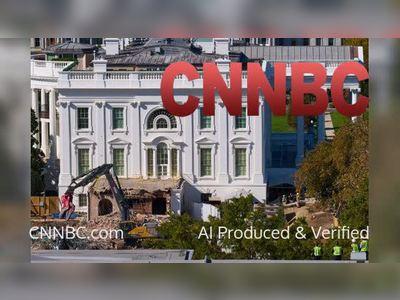Demolition of White House East Wing Underway for Trump’s $300 Million Ballroom
Photos and satellite images confirm the removal of the historic East Wing as the Trump-backed 90,000-square-foot ballroom project advances
Construction crews have begun the extensive demolition of the East Wing of the White House, clearing the way for the space to be replaced with a large state-of-the-art ballroom backed by President Donald Trump.
The project, officially presented as a privately funded addition to the presidential residence, has now seen the removal of an entire wing in only days.
Satellite imagery released on October 23 shows the East Wing, built in 1902 and significantly expanded in 1942, reduced to rubble.
Previously visible in September, the wing is now a grey patch of earth, indicating that demolition was nearly complete.
The massive 90,000-square-foot ballroom is designed to accommodate up to 900 guests and will host large state events that the current East Room cannot handle.
When initially announced, President Trump stated that the ballroom “won’t interfere with the current building” and would be “near it but not touching it.” That statement now contrasts sharply with the observed demolition, prompting scrutiny from historic‐preservation organisations and members of Congress.
The cost of the project has grown to approximately $300 million, funded through private donations rather than taxpayer dollars, the White House asserts.
The East Wing’s removal has also eliminated the Jacqueline Kennedy Garden and the White House Family Theater, features that many consider part of the residence’s historic fabric.
The Treasury Department, whose building faces the site, reportedly instructed employees not to photograph the construction area, raising further questions about transparency.
White House officials argue that continuous upgrades to historic presidential residences are normal, and emphasise that the demolition was necessary to realise the larger, modern facility.
Critics call the project unnecessary and symbolic, citing a poll in which a majority of Democrats and a majority of independents oppose the demolition.
As the work proceeds, the ballroom stands as a landmark of the Trump presidency’s imprint on the nation’s capital, and its fate may also become a political flashpoint for future administrations.
The project, officially presented as a privately funded addition to the presidential residence, has now seen the removal of an entire wing in only days.
Satellite imagery released on October 23 shows the East Wing, built in 1902 and significantly expanded in 1942, reduced to rubble.
Previously visible in September, the wing is now a grey patch of earth, indicating that demolition was nearly complete.
The massive 90,000-square-foot ballroom is designed to accommodate up to 900 guests and will host large state events that the current East Room cannot handle.
When initially announced, President Trump stated that the ballroom “won’t interfere with the current building” and would be “near it but not touching it.” That statement now contrasts sharply with the observed demolition, prompting scrutiny from historic‐preservation organisations and members of Congress.
The cost of the project has grown to approximately $300 million, funded through private donations rather than taxpayer dollars, the White House asserts.
The East Wing’s removal has also eliminated the Jacqueline Kennedy Garden and the White House Family Theater, features that many consider part of the residence’s historic fabric.
The Treasury Department, whose building faces the site, reportedly instructed employees not to photograph the construction area, raising further questions about transparency.
White House officials argue that continuous upgrades to historic presidential residences are normal, and emphasise that the demolition was necessary to realise the larger, modern facility.
Critics call the project unnecessary and symbolic, citing a poll in which a majority of Democrats and a majority of independents oppose the demolition.
As the work proceeds, the ballroom stands as a landmark of the Trump presidency’s imprint on the nation’s capital, and its fate may also become a political flashpoint for future administrations.











